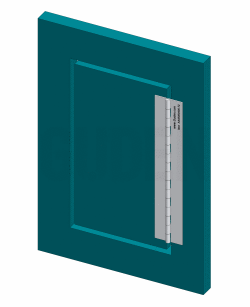Things to Consider When Choosing a Continuous Hinge

Sampling and Testing
Want free continuous hinge engineering samples? Sure! We know the value of prototyping and testing, and we strive to fill reasonable design sample requests quickly. Building a prototype shouldn't have to be a major expense and an engineering analysis of a prototype is usually the best way to confirm that you have selected a safe and effective product for your application. Working with the right supplier is the key to the success of your design process and you've already made a great choice with Guden, the hardware experts. With almost 100 years of experience, the samples, information and advice you can get from us can be priceless in getting your prototype off the ground and onto the production floor.
Coverage

Continuous hinges can completely fill or cover the space between your door and chassis. Hiding this gap or juncture can greatly improve the look of your application.
Leaf Material and Thickness
| • Plain Steel - affordable |
| • Stainless Steel - corrosion resistant |
| • Aluminum - lightweight & corrosion resistant |
Plain steel, type 302/304 stainless steel, type 316 stainless steel and types 5052 & 3003 aluminum are
the most popular material choices for a continuous hinge. It is also common to have the hinge material match the material of the
cabinet or box.
For material thickness, a good starting point is to select the same thickness as the enclosure. If the enclosure has some unusual weight
distribution, or high or low door loads you may want to increase or possibly decrease the thickness.
Pin Size
There are usually only 1 or 2 choices of pin diameter for a given thickness of a continuous hinge. As a general rule of thumb, the strongest continuous hinge is one where the pin diameter is about twice the material thickness.
Knuckle Size
| Thickness | More Popular Knuckle Sizes | Less Popular Knuckle Sizes |
|---|---|---|
| .025 | .25 | .50 |
| .032 | .50 | .25 |
| .035 | .25 | |
| .040, .050, .060 | .50, .75, 1.00 | .625, 2.00 |
| .072, .075 | .50, 1.00 | 2.00 |
| .090 | 1.00 | 2.00 |
| .120, .179 | 2.00 | |
| .250 | 1.50 | 2.00 |
There are several knuckle sizes that are standard to most hinge manufacturers and sticking with the most popular one can make all the difference in the hinge pricing. The overall length of the hinge may also be a deciding factor because hinges with all full knuckles tend to be cheaper. See more in the next section.
Overall Length
Stock lengths of continuous hinges are available in either 72”, 84” or sometimes 96” length depending on the size and their popularity. We can supply them cut to any length you want but if you can keep the length an equal multiple of the knuckle size you choose, it can often be less expensive. But choosing the more expensive option can help with retaining your pin due to a deformed knuckle end. See next section.
Pin Retention
| • Staked Pin - Semi-Fixed (.075 thickness and below) |
| • Coined Pin End - Semi-Fixed (.060 thickness and below) |
| • Welded Pin Ends - Fixed (all thicknesses) |
| • Crimped or Crushed Pin End - Fixed (.090 thickness and below) |
| • Spun Pin Both Ends - Fixed (all thicknesses) |
| • None – Pin Retained by Friction (all thicknesses) |
Many longer length of hinges are often left without any pin retention at all because the pin is retained pretty much just from the long length of hinge, or the hinge is set into a space that doesn't allow the hinge pin to come out. But to prevent the hinge pin from "walking out" of the barrel, it's best to use some kind of pin retention. The more stakes you have, the less chance that the pin will be able to be taken out of the hinge. Keep in mind that in .035, .040, .050 and .060 thicknesses, hinges are run standard with a stake every 3-4 inches which can be very cost effective. Coined pin ends retain the hinge pin, but can easily be hammered out if need be. In most cases, a partial knuckle is not desirable, but one advantage is that the deformed end often will sufficiently retain the pin without the need for an extra operation.
With or Without Mounting Holes
| • No holes for welding |
| • Standard holes or slots |
| • Standard countersunk holes |
| • Custom hole or slot sizes and patterns |
| • Custom threaded inserts |
The majority of hinges without holes are mounted by welding, but for easier mounting, many hinges are supplied with either holes, slots or custom threaded inserts or studs. Various standard hole patterns are readily available and just about any hole pattern you would require can also be supplied. Keep in mind that some non-standard patterns may require a tooling charge.
Custom Bends / Cuts / Swages
Don't forget that if you plan to modify the hinge, it might be cost effective to have the supplier do the custom operations for you. In addition to holes, slots and plating, hinges can be cut to length, bent, swaged, offset, and trimmed - nearly anything is possible. Simply provide us with a dimensional drawing to get a price quote.
Finish
| • Chemical Conversion | • Degrease | • Powder-coat |
| • Anodize | • Electro-Galvanize | • Polish |
| • Black Oxide | • Electropolish | • Passivated |
| • Burnished | • Nickel | • Zinc |
| • Chrome | • Paint | • NADCAP |
One of the last decisions to make on your hinge is the finish. Often your continuous hinge will be finished along with the rest of your assembly, but if needed, Guden can supply the hinge with your specified finish. Most hinge lengths are in stock without a finish, and we also have a line of polished stainless continuous hinges suitable for the marine industry, medical and food industries or any application that needs a corrosion resistant hinge with a bright shiny finish. You can also choose from a selection of pre-plated brass and nickel continuous hinges that are also pre-punched with holes.
Considering a Continuous hinge for your application? Click here to see our standard Continuous hinges.



